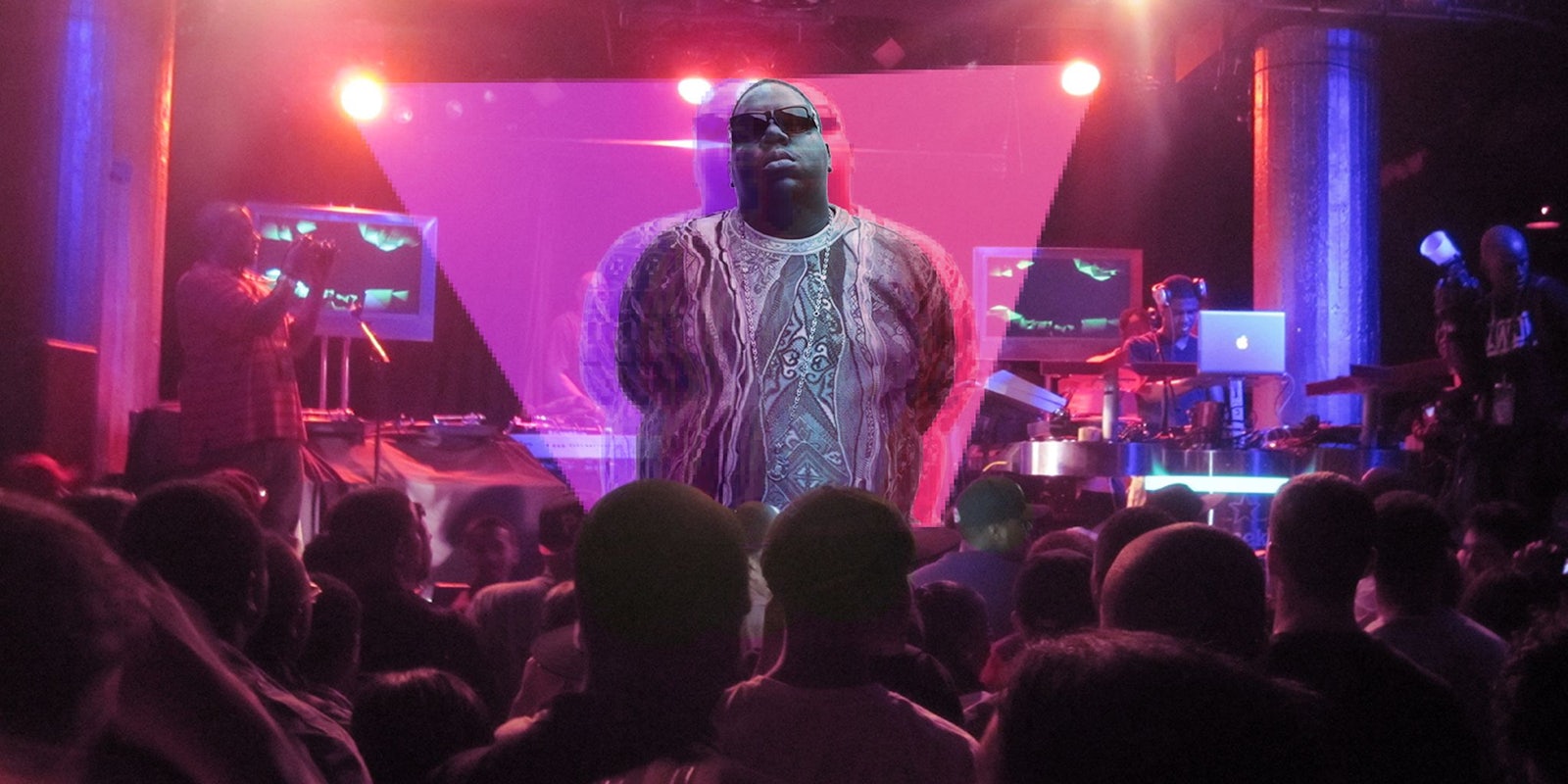Biggie Smalls, aka The Notorious B.I.G., will get to live every day as a struggle once again.
Augmented Reality Hologram Technology, a firm which promises the most life-like and believable holograms in this quickly growing business, has acquired Christopher Wallace’s likeness and intends to use it on tour with his former wife, R&B singer Faith Evans. As ARHT founder Rene Bharti told Billboard, the company specializes in “the creation of a digital human, being it living, deceased in this case or even fictional.” While the company prefers the term “humagram” for its projections of the rich and famous, it’s another step towards the normalization of this unique method of reviving the dead.
Typically, such attempts are given the appropriate sneer by the public as desperate, awkward attempts to cash-in on the creepy recreation of a dead person’s image and talent. In 2012, a hologram of Tupac Shakur—another artist lost to an untimely and violent death—created an explosion of headlines and gimmickry attempts to copycat the “success” of the projection at Coachella 2012. “There exists a token of beauty in letting Pac’s music speak for itself,” wrote Jason Lipshutz at the time, “and not grafting a false image onto his classic sounds simply because we missed Tupac perform when he was alive and want to see him now.”
Holograms are a continuation of our incessant fear of pop culture death.
That drive to resurrect performers—particularly those stripped before their potential could be reached—can be a strong one, and one backed by good intentions. But the results can be a bit creepier than the concert, venue, artist, or technology behind the decision might intend. Far more than hacky special effects, however, holograms are a continuation of our incessant fear of pop culture death.
Despite the mountains of evidence to the contrary, we often believe our favorite pop culture entities—namely the ones from our youth—can be saved from death or obscurity and recreated for modern fame and ubiquity. Hollywood has become a recycling engine of intellectual properties few asked to be revived. Disney expects live-action recreations of The Jungle Book and Pete’s Dragon to breathe new life into long-dead storylines, as well as its various ventures into the canon of Marvel Comics and Star Wars.
Netflix has pulled dead TV programs like Full House and Gilmore Girls out of their cold graves and back into the light of day (where they might not shine as brightly as they did in a past life). Nickelodeon has fully embraced the wave of 90s nostalgia that probably should have crashed before it started, airing a block of programming nightly and even promising a full reunion of the children’s sketch comedy show All That.
In music, for various reasons, this can be hard to do. Recreating songs in one’s own image isn’t exactly sacrilege—artists cover each other all the time—but recent years have seen rather blatant knockoffs of formerly popular hits. The chorus of Melanie Martinez’s song “Cry Baby” is identical to that of the 1963 song “It’s My Party.” Pitbull and Christina Aguilera sold “Take On Me” as an original song with 2012’s “Feel This Moment.” Glee, the since-canceled FOX musical series, became one of the top selling music groups in history with its note-for-note performances of the full array of music you’d hear in your dentist’s office.
We crave the immortality of the things we love in all sorts of ways—be it from movie franchises or television or music.
The live equivalent of this appetite for recreation is the hologram. Tupac had been preceded by Celine Dion, who has heavily employed holograms in her live Las Vegas show and sang a duet with the late Elvis Presley in a 2010 appearance on American Idol. Whitney Houston, who died just four years ago, will go on tour in hologram form later this year. She’ll be joined by Buddy Holly, whose visage will be gracing stages across Texas.
In 2012, Gawker predicted an all-hologram lineup at Coachella featuring Michael Jackson, The Clash, and Mozart. And a 2014 episode of South Park imagined holograms replacing the work of actual performing artists. But such dire warnings about the hypothetical damage caused by holograms to the supposed sanctity of the work of musical legends misses the point. We crave the immortality of the things we love in all sorts of ways—be it from movie franchises or television or music.
In fact, the gatekeeping executives and producers we might blame for our rehashed, tired usage of old pop culture might say original work is too big a risk for the investment—meaning the nostalgic appeal of old movies, old music, and old artists is so strong it outweighs whatever disgust we might collectively feel about bringing the dead back to life. If we were so tired of seeing these spectacles, movie and TV studios wouldn’t be spending billions to make us care about superheroes or fictional families we forgot existed.
If holograms were so abhorrent—and not just the next logical phase in our addiction to nostalgia—they wouldn’t even exist. We as audiences have already proven the validity of a media investment strategy that rewards reanimation over innovation. Holograms are no different an attempt to cash in on our historical vanity than Batman vs. Superman or the long-awaited arrival of The Animaniacs on Netflix. It’s simply because they focus on a central person–instead of just a song or other intellectual property—that we begin to feel how creepy and wrong it is to keep reliving the past.
Gillian Branstetter is a social commentator with a focus on the intersection of technology, security, and politics. Her work has appeared in the Washington Post, Business Insider, Salon, the Week, and xoJane. She attended Pennsylvania State University. Follow her on Twitter @GillBranstetter.


